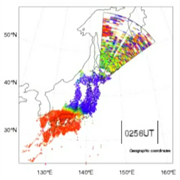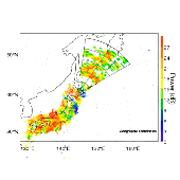Movie Gallery
Large Scale Traveling Ionospheric Disturbances (LSTIDs) (m1v 3MB)
LSTIDs are propagating ionospheric electron density perturbation structures, and are considered to be generated by the propagation of atmospheric gravity waves generated by Joule heating in the high latitude ionosphere. Simultaneous LSTID observation by the SuperDARN Hokkaido radar and GPS receiver network showed that the Total Electron Content (TEC) increase is accompanied by the downward motion of the reflection point of HF radar waves, which is consistent with the model calculation of atmospheric gravity waves using observed LSTID parameters.
(Hayashi et al., J. Geophys. Res., 2010)
Nighttime Medium Scale Traveling Ionospheric Disturbances (MSTIDs) (mpg 2MB)
Nighttime MSTIDs are propagating ionospheric electron density perturbation structures, and are considered to be generated by ionospheric plasma instabilities. Japanese GPS receiver network data showed that the nighttime MSTIDs propagate mainly southwestward. Simultaneous MSTID observation to the north of Japan by the SuperDARN Hokkaido radar and GPS receiver showed that the MSTID propagation direction can be sometimes northward, and depends on latitude and local time.
(Ichihara et al., Adv. Polar Sci., 2013)
Coseismic ionospheric disturbance after the 2011 Tohoku earthquake (m1v 0.7MB)
Coseismic ionospheric disturbances are considered to be caused by gravity or acoustic waves propagating upward from the earth's surface. 10 min after the 2011 Tohoku earthquake (M=9.0), the SuperDARN Hokkaido radar observed ionospheric disturbances propagating away from the epicenter with the maximum seed exceeding 6 km/s. This high speed is interpreted in terms of the seismic waves propagating on the surface of or inside the earth, leading to upward propagating atmospheric acoustic waves, reaching up to the ionosphere.
(Nishitani et al., Earth Planets Space, 2011; Ogawa et al., Earth Planets Space, 2012)





